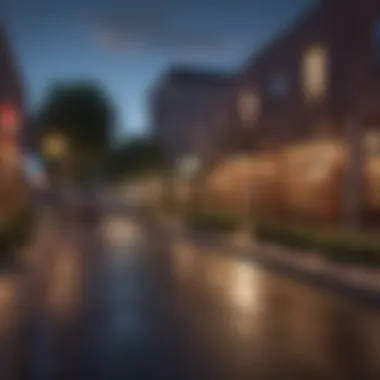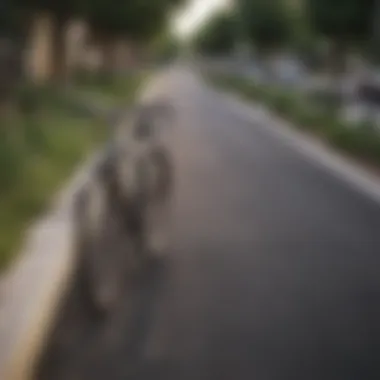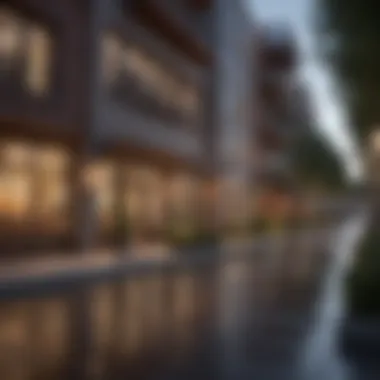Exploring Walkable Neighborhoods in Austin


Intro
Austin, Texas, is often celebrated for its vibrant culture, innovative spirit, and dynamic neighborhoods. One aspect that increasingly draws attention is the concept of walkable neighborhoods. These areas allow residents and visitors to navigate the city with ease, prioritizing pedestrian accessibility. This article delves into the layers of urban design, community engagement, and overall benefits that walkability brings to the lives of those who inhabit this lively city.
Understanding walkable neighborhoods involves recognizing the critical elements that contribute to a richer urban experience. These include designs that promote social interaction, accessible public spaces, and varied amenities within a short distance. As urban planning evolves, the significance of these neighborhoods cannot be overstated. They offer a distinct lifestyle that connects individuals more closely with their environment. Within the context of Austin, this exploration takes on added importance as the city faces growing challenges related to sustainability and livability.
In this comprehensive overview, we will examine the notable walkable areas in Austin, analyze the policies impacting their development, and uncover what makes these neighborhoods not just sought-after, but essential for a thriving community.
Home Features
Architectural Marvels
Austin's walkable neighborhoods showcase a blend of styles, reflecting the city's diverse history. You can find historical homes alongside modern architectural feats. Each structure serves as a testament to the city’s commitment to preserving its unique character while adapting to contemporary needs. Notable examples include the influence of mid-century modern homes, which harmonize with the environment around them, and more recent developments that prioritize sustainability.
- Historical Influences: Many neighborhoods retain their original charm, with houses featuring classic facades and intricate details.
- Modern Ecosystem: New builds often incorporate green roofs, solar panels, and energy-efficient designs.
"Walkable neighborhoods encourage sustainable living and closer community ties."
Unique Design Elements
In addition to varied architecture, the design elements of homes in walkable neighborhoods promote a lifestyle centered around ease of interaction and sustainability. Elements to consider include:
- Porches and Outdoor Spaces: Many homes have inviting porches that encourage neighbors to engage with each other while enjoying the Texas climate.
- Open Floor Plans: Interior designs often favor open living areas that facilitate social gatherings, making homes feel spacious and inviting.
Interior Design Inspirations
Color Palettes and Themes
The aesthetic of homes in walkable neighborhoods embraces palettes that resonate with nature. Soft earthy tones such as greens, browns, and soft blues often dominate. These colors not only enhance the beauty of the home but also foster a connection to the vibrant surroundings of Austin.
- Local Art Influence: Art sourced from local artists frequently adorns the interiors, embedding the community’s creativity within private homes.
Furniture Arrangement Tips
Effective furniture arrangement can amplify the welcoming nature of a home. Focus on layouts that promote conversation and movement, ensuring guests feel as much at ease as residents. Consider the following tips:
- Transitional Spaces: Use transitional spaces effectively so that there is a natural flow from the interior to the exterior.
- Functional Zones: Designate functional zones that allow for relaxation, dining, and social interaction without hindering movement.
This exploration of walkable neighborhoods in Austin highlights the myriad ways in which urban design intersects with community values, offering a model for other cities to follow.
Foreword to Walkable Neighborhoods
Walkable neighborhoods play a crucial role in improving the quality of urban life. Understanding this concept can help residents, urban planners, and policymakers appreciate the significance of designing spaces that prioritize pedestrian access. This article aims to shed light on the essence of walkable neighborhoods in Austin and their multifaceted benefits.
These neighborhoods encourage active living and foster a sense of community, making them essential components of urban planning. As cities expand, maintaining a balance between accessibility and sustainability becomes vital. A focus on walkability can enhance social interaction, improve health outcomes, and contribute to environmental sustainability.
In the following sections, we will explore what defines a walkable neighborhood and its historical origins, providing context for its rising importance in contemporary urban design.
Definition and Importance
A walkable neighborhood is one where daily necessities and amenities are accessible on foot. These places enhance the well-being of their residents as they significantly reduce the reliance on automobiles. Residents often find services such as grocery stores, schools, parks, and public transportation within a short distance, making life more convenient.
The importance of walkable neighborhoods goes beyond convenience. They provide numerous benefits, including:
- Economic advantages: Local businesses thrive when foot traffic increases.
- Health benefits: Walking contributes to physical fitness and mental well-being.
- Environmental sustainability: Reduced vehicle usage leads to lower emissions and less congestion.
- Enhanced quality of life: People enjoy a better living experience when they can engage with their surroundings directly.
Promoting walkability is an effective strategy for cities aiming to elevate their livability.
History of Walkable Urban Design
The principles of walkable urban design can be traced back centuries. Historically, cities were developed with a focus on pedestrian access. Streets were narrower, and mixed-use developments created vibrant community spaces. These urban areas emphasized local commerce, social interaction, and public gathering spaces.
However, the rise of the automobile in the mid-20th century shifted the focus towards car-centric planning. This led to urban sprawl and a decline in pedestrian-friendly spaces.
In recent decades, there has been a resurgence of interest in walkable neighborhoods. Urban planners now emphasize retrofitting cities to encourage walking and biking. Efforts include redesigning streetscapes, increasing public transport options, and creating pedestrian pathways. This shift aims to rekindle the essence of urban living, fostering environments that support not just movement but community engagement.


"Walkable neighborhoods epitomize modern urban design, combining functionality with community spirit."
The Appeal of Austin's Walkable Communities
The concept of walkable neighborhoods in Austin holds significant appeal for various reasons. Such communities promote a more integrated lifestyle, emphasizing accessibility and a strong sense of place. In these neighborhoods, residents typically find essential services, parks, and recreational areas within a comfortable walking distance. This proximity fosters interaction among residents, enhancing local bonds and the overall community experience.
Cultural Vibrancy and Amenities
Austin is widely recognized for its vibrant cultural scene. Walkable neighborhoods contribute to this by housing numerous amenities that cater to diverse preferences.
- Local Restaurants and Cafes: From food trucks to high-end dining, a variety of culinary experiences await.
- Art Galleries and Music Venues: The presence of local artists and musicians helps maintain Austin's identity as the "Live Music Capital of the World."
- Retail Options: Shops that offer unique goods, including artisan crafts and vintage finds, are often situated within walking distance.
- Seasonal Markets: Many neighborhoods host weekly farmers’ markets, making fresh produce easily accessible.
These amenities not only enrich the cultural fabric of the community but also encourage residents to spend more time outdoors, walking and engaging with their surroundings. The result is a lively atmosphere that reflects the city’s unique personality.
Health Benefits of Walkable Living
Living in a walkable neighborhood can have numerous health advantages. These include:
- Increased Physical Activity: Walking becomes a more feasible option, promoting a healthier lifestyle. Studies show that residents in walkable areas tend to meet or exceed recommended physical activity levels.
- Improved Mental Well-Being: Access to green spaces and the opportunity for social interactions contribute positively to mental health.
- Reduced Reliance on Vehicles: Lower usage of cars leads to decreased air pollution and less stress related to traffic.
"Walkable neighborhoods not only enhance physical health but also foster mental wellness through community engagement and outdoor activity."
Notable Walkable Neighborhoods in Austin
The exploration of Austin's walkable neighborhoods reveals a rich tapestry of urban design and community spirit. Each neighborhood offers unique characteristics that contribute to the overall appeal of the city. They foster convenient access to various amenities, promote social interactions, and ultimately enhance the quality of life for residents. Knowing these neighborhoods allows potential homeowners and urban planners to appreciate what makes Austin distinct in the context of walkability.
Downtown Austin
Downtown Austin serves as the city’s vibrant heart. Here, locals and visitors alike find a blend of cultural attractions, dining options, and entertainment venues. The streets are often bustling, encouraging a lively atmosphere for pedestrians. The Texas State Capitol is a noteworthy landmark, easily reachable on foot.
A key aspect of Downtown Austin is the presence of mixed-use developments. This means residents can enjoy living spaces above retail shops, leading to an integrated lifestyle that supports daily needs. The urban core also features numerous public transportation options, further facilitating mobility without the reliance on vehicles.
South Congress (SoCo)
South Congress, commonly known as SoCo, is a neighborhood that showcases a quirky and artistic vibe. This area is famed for its eclectic boutiques and food trucks, attracting those looking for a taste of local culture. Walking down South Congress Avenue reveals local art murals and unique shops, inviting exploration.
Furthermore, SoCo benefits from a close-knit community feel, marked by events and festivals throughout the year. These community gatherings foster connections among residents while also attracting tourists, making it a lively spot for social engagement.
West Campus
West Campus is positioned adjacent to the University of Texas at Austin, catering primarily to students. This neighborhood provides an array of affordable housing options, emphasizing the importance of access for a younger demographic. The vicinity boasts a variety of coffee shops, eateries, and parks, making it conducive for pedestrians.
What stands out in this neighborhood is the organizational structure of amenities. Numerous local businesses operate in close proximity to student housing, allowing for a seamless lifestyle. This design promotes walking and biking, significantly reducing traffic congestion.
Mueller
Mueller is a master-planned community that exemplifies the modern approach to walkability. Located on the site of a former airport, this neighborhood includes a mix of residential, commercial, and recreational spaces. Mueller’s layout includes connected parks and walking trails that encourage outdoor activities.
The community design incorporates various home styles, catering to diverse demographics. It emphasizes sustainability and connectivity, promoting a lifestyle where residents can walk to shops or parks. As a result, the Mueller community has become a model for future developments in Austin.
East Austin
East Austin is often described as the cultural heartbeat of the city. This neighborhood is home to a diverse population and showcases a variety of creative fronts, including art galleries and music venues. The streets of East Austin invite exploration with food spots representing different cultures, allowing residents to experience a global culinary journey.
The area has also seen increased attention from developers, aiming to preserve its cultural essence while enhancing walkability. Although this brings both opportunity and challenges, the focus remains on maintaining the vibrancy that defines East Austin.
"Austin's walkable neighborhoods prioritize community engagement and accessibility, making them a model for future urban planning endeavors."
Through the examination of these notable neighborhoods, one can observe how each contributes to Austin’s overall walkability. They present different aspects, from cultural vibrancy to community involvement, all while enhancing the experience of urban living.
Design Characteristics of Walkable Neighborhoods
The design characteristics of walkable neighborhoods play a crucial role in enhancing the quality of life for residents and visitors alike. When a neighborhood is well-designed with the intention of promoting walkability, it creates an environment that encourages social interaction, reduces dependence on vehicles, and supports local businesses. These elements are essential for fostering a sense of community and improving urban sustainability. Here, we explore several key design characteristics that contribute to the walkability of neighborhoods in Austin, Texas.
Pedestrian-Friendly Infrastructure


Pedestrian-friendly infrastructure is fundamental to creating a walkable community. This includes elements such as wide sidewalks, safe street crossings, and well-placed signs that guide individuals. The aim is to ensure that walking feels safe and accessible. In Austin, investments in pedestrian infrastructure have been increasing, with ongoing projects designed to improve connectivity.
Here are some key features that enhance pedestrian-friendly infrastructure:
- Sidewalks that are wide and clear of obstacles.
- Crosswalks with proper signaling to ensure safe crossings.
- Traffic calming measures that reduce vehicle speeds in residential areas.
Together, these elements help to create an inviting atmosphere for pedestrians. However, ongoing evaluation of pedestrian needs is vital. Regular feedback from the community can lead to continuous improvements, ensuring that infrastructure evolves along with urban growth.
Mixed-Use Development
Mixed-use development is crucial in fostering vibrant and engaging neighborhoods. This design characteristic allows for residential, commercial, and recreational spaces to coexist. In Austin, mixed-use developments can often be found, where coffee shops, restaurants, and shops are situated within close proximity to housing. This encourages individuals to walk to access daily needs instead of relying on cars.
The advantages of mixed-use development include:
- Increased foot traffic that benefits local businesses.
- Reduced need for long commutes, which can lead to improved mental health and reduced stress.
- A dynamic atmosphere that contributes to a sense of community.
Designing neighborhoods with a mixed-use concept aligns with sustainable practices. It promotes local economies while decreasing reliance on vehicles, ultimately leading to lower carbon emissions.
Green Spaces and Public Plazas
Green spaces and public plazas are essential components of walkable neighborhoods. These areas provide necessary relief from urban density and offer spaces for relaxation, play, and social interaction. Parks, gardens, and plazas can act as community hubs, where people gather for events, picnics, or simply to enjoy the outdoors.
Some benefits of green spaces include:
- Enhanced mental well-being through nature exposure.
- Opportunities for exercise and outdoor activities.
- Spaces for community events and social gatherings.
In Austin, the incorporation of parks and plazas within neighborhoods contributes to their walkability. People feel more inclined to walk when pleasant green areas are situated nearby, making neighborhoods more attractive. Understanding the integration of these elements will promote further development that prioritizes community health and sustainability.
"Walkability is not just about walking; it’s about creating an environment that nurtures social interactions and community ties."
Sustainability and Walkability
Sustainability and walkability are critical in fostering livable communities. The integration of these concepts promotes not only the physical accessibility of neighborhoods but also ensures they are environmentally responsible. By minimizing dependence on automobiles, walkable environments encourage a healthier lifestyle and a more sustainable future. Urban design that prioritizes walking can lead to a significant reduction in pollution levels and promotes the use of public spaces.
Environmental Impact
The construction of walkable neighborhoods also has notable environmental effects. By incorporating features like bike lanes, sidewalks, and pedestrian paths, these areas see less vehicular traffic. The shift away from cars reduces exhaust emissions, which is vital for improving air quality. Furthermore, walkable designs often include green infrastructure, such as permeable pavements and urban green spaces, which help manage stormwater and enhance biodiversity.
- Benefits of Reduced Pollution:
- Improved air quality.
- Lower greenhouse gas emissions.
- Healthier ecosystems.
Additionally, walkable neighborhoods often promote public transportation options, thus decreasing the environmental footprint of commuting. These neighborhoods can encourage a communal spirit, where engaging with local businesses becomes common, leading to less reliance on large, polluting corporations. Consequently, the environment benefits, illustrating a direct connection between walkable designs and ecological stewardship.
Reducing Carbon Footprint
Reducing the carbon footprint of communities is an essential consideration in developing walkable neighborhoods. By enabling easy access to amenities and services, walkable environments discourage the use of single-occupancy vehicles and encourage walking or biking instead. This shift can contribute notably to lowering overall carbon emissions.
"Creating walkable neighborhoods can potentially cut individual carbon footprints by up to 50% compared to car-dependent areas."
While one neighborhood may not seem significant individually, the cumulative benefits across larger populations can lead to substantial reductions in carbon output. Here are some strategies to further reduce carbon footprints within these communities:
- Promote Public Transit:
Encouraging reliable public transport options, such as buses and light rail, decreases reliance on personal vehicles. - Enhance Cycling Infrastructure:
Safe and accessible bike lanes not only promote cycling but also reduce carbon emissions from short-distance drives. - Encourage Mixed-Use Developments:
By integrating residential and commercial spaces, the need for long commutes is decreased.
The move towards sustainability and walkability is essential for environmental preservation. Through conscious urban planning and community engagement, Austin's neighborhoods can lead the way in showcasing how a thoughtful approach to development can yield both sustainable and vibrant living environments.
Challenges in Creating Walkable Neighborhoods
The endeavor to create walkable neighborhoods in Austin presents both exciting possibilities and significant obstacles. For urban planners, homeowners, and residents alike, it is essential to understand these challenges in order to work towards solutions. Walkable communities offer many benefits, including reduced car reliance and enhanced community interaction. However, hurdles arise that complicate the development process and risk undermining these advantages.
Zoning Regulations
Zoning regulations play a significant role in shaping the physical landscape of neighborhoods. These rules determine how land can be used, influencing everything from the types of buildings permitted to their density. In many cases, zoning laws favor single-family homes over mixed-use developments. Such restrictions can stifle the growth of walkable areas where diverse amenities exist within proximity.
As cities like Austin grow rapidly, effective zoning reform becomes crucial for fostering walkability.


- Adjusting zoning can help facilitate:
- This can ultimately create vibrant neighborhoods that promote pedestrian engagement.
- Mixed-use developments that combine residential, commercial, and recreational areas
- Increased housing density in central locations
Gentrification Concerns
Gentrification is another critical challenge in creating walkable neighborhoods. A community’s revitalization can attract new residents and businesses, enhancing its appeal. However, this often leads to higher property values and rents, displacing long-term residents. The balance of development must consider both existing community needs and the potential for change.
Strategies to mitigate gentrification might include:
- Introducing affordable housing projects
- Implementing policies that protect current residents from displacement
- Encouraging local businesses to flourish along with new developments
Such approaches may support a more equitable transition toward walkable living environments.
Community Resistance
Lastly, community resistance poses a barrier to creating walkable neighborhoods. Residents may have concerns regarding increased traffic, noise, or a loss of neighborhood character. These apprehensions can lead to opposition against developments that promote walkability.
Engaging with the community is vital. Developers and planners must prioritize transparent discussions:
- Hosting community meetings to discuss vision and hear concerns
- Ensuring that local voices shape planning decisions
- Providing detailed plans that demonstrate potential benefits
"Successful walkable neighborhoods emerge not only from good planning but from collaborative efforts across all community stakeholders."
In summary, while the concept of walkable neighborhoods is appealing, the challenges presented by zoning regulations, gentrification concerns, and community resistance must be addressed thoughtfully. Only with careful consideration can Austin move towards creating spaces that prioritize both accessibility and community engagement.
Future of Walkable Neighborhoods in Austin
The concept of walkable neighborhoods is gaining traction in urban planning discussions across the United States, including in Austin, Texas. These communities offer a variety of benefits, such as reduced traffic, improved access to amenities, and enhanced quality of life. As Austin continues to grow, understanding the future of these walkable neighborhoods becomes crucial. This section analyzes the evolving urban design initiatives and community engagement efforts that shape the city’s commitment to creating accessible living environments.
Urban Planning Initiatives
Urban planning is at the forefront of developing walkable neighborhoods in Austin. Several planning initiatives focus on creating pedestrian-friendly spaces that encourage residents to walk rather than drive. These initiatives prioritize mixed-use development, where residential, commercial, and recreational spaces coexist. This not only boosts local businesses but also creates vibrant, closely-knit communities.
Key components of successful urban planning in Austin include:
- Complete Streets Policy: Aiming to incorporate safety for all users, including pedestrians and cyclists.
- Investment in Public Transit: Improving the public transport system enhances connectivity, making walking more appealing for residents.
- Zoning Reforms: Adjustments to zoning laws can help facilitate the building of denser, mixed-use developments.
As projects like the Project Connect transit plan unfold, they promise to integrate various neighborhoods more effectively, reducing dependency on cars and promoting sustainable mobility. Such planning efforts are essential in ensuring that Austin's growth does not compromise its livability and accessibility.
Community Engagement Efforts
Community engagement plays a vital role in shaping the future of walkable neighborhoods in Austin. Involving residents in planning discussions can lead to solutions more closely aligned with their needs and preferences. Effective community outreach initiatives are key for fostering a sense of ownership among residents.
Some common community engagement strategies include:
- Public Forums and Workshops: These platforms allow residents to voice their concerns and suggestions.
- Online Surveys: Utilizing digital tools helps gather feedback from a broader audience, making participation more convenient.
- Partnerships with Local Organizations: Collaborating with non-profits or community groups ensures diverse perspectives are included in planning discussions.
Inclusive engagement efforts can significantly improve community trust and support for urban projects. As a result, local enthusiasm may lead to increased participation in neighborhood activities and lower resistance to necessary changes in zoning or infrastructure.
"Creating walkable neighborhoods isn't just about design—it's about fostering a community and a sense of belonging."
Considering these aspects, the future of walkable neighborhoods in Austin appears promising. By continuing to invest in strategic urban planning and meaningful community engagement, the city can enhance its quality of life and build strong, accessible neighborhoods for all residents.
Ending
The exploration of walkable neighborhoods in Austin reveals significant insights into urban living. Understanding the implications of such concepts is paramount. Walkable neighborhoods foster not only convenience but a sense of community. Access to local amenities encourages social interactions, enhancing the quality of life. Residents in these areas often enjoy better mental and physical health due to increased walking and outdoor engagement. The interconnectedness of various urban elements promotes sustainability too.
Summary of Key Points
A few key elements about walkable neighborhoods include:
- Community Engagement: Residents actively participate in their surroundings. This participation strengthens neighborhood bonds, creating a vibrant social fabric.
- Safety and Accessibility: Walkable areas are generally viewed as safer due to more pedestrians. Streets designed for pedestrians reduce vehicular accidents, promoting a sense of security.
- Economic Growth: Businesses in walkable neighborhoods benefit from higher foot traffic. Local economies thrive when local residents engage with establishments nearby.
- Environmental Considerations: Reduced reliance on cars contributes to lower emissions. This shift plays a crucial role in combating urban pollution.
Call for Continued Development
The need for continued development of walkable neighborhoods cannot be overstated. Urban planners and policymakers must prioritize these areas as they evolve. Such developments are essential to meet the growing demand for sustainable and accessible living environments. Continued dialogue within communities around urban planning can yield strategies that align with residents’ needs.
Investments should focus on:
- Improving pedestrian pathways to enhance safety.
- Expanding public transport options to support walkability.
- Incorporating green spaces that encourage outdoor activities.



